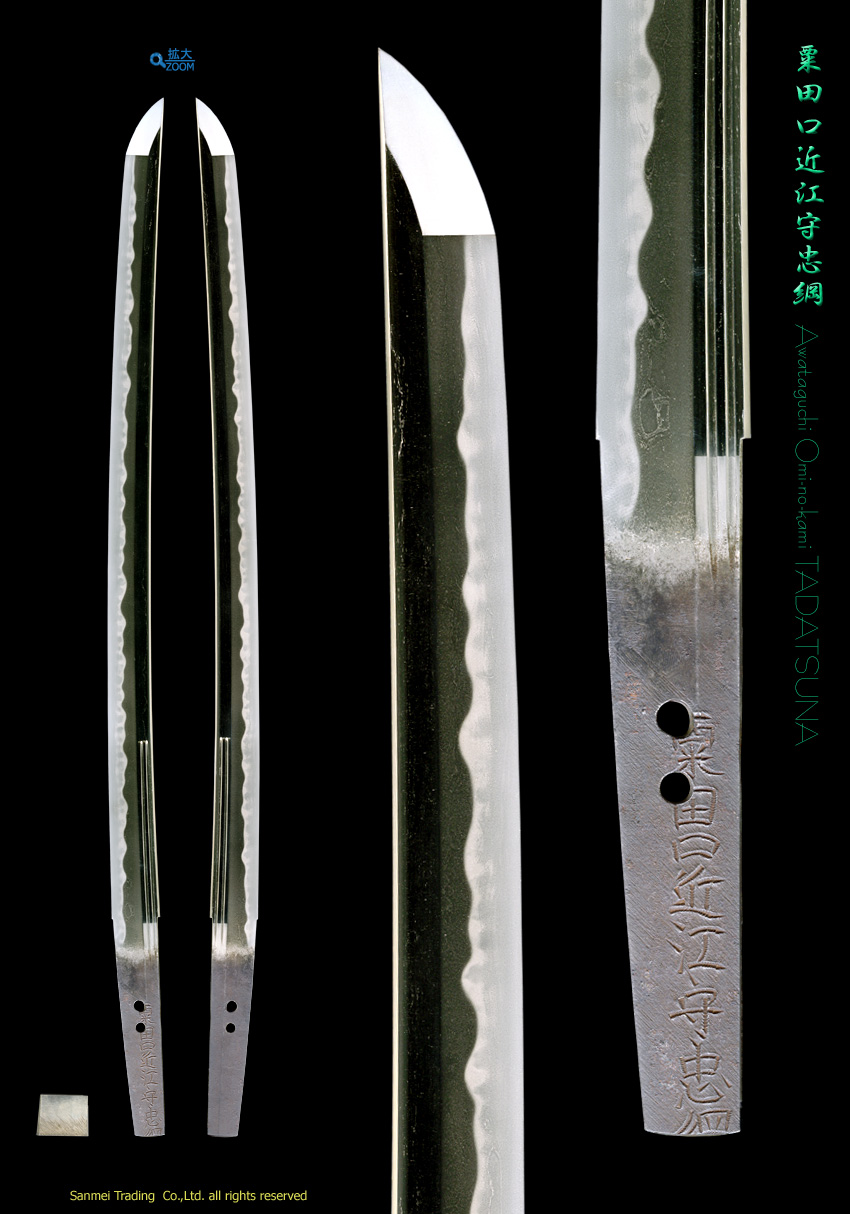Length of cutting edge51.5cm Curvature0.7cm Width of base30.6mm Thickness of base6.5mm Width of Yokote22.3mm
Forging pattern (kitae hada) : Kitae hada is minute Ko-Itame hada with mixture of Ko-Mokume. The entire forging steel is covered with fine ji-nie (hard metal granules over the surface) that generates close Nie lines along wooden grain so called CHIKEI activity.The entire forging pattern looks like the cut end of a pear with flecked effect so called "Nashiji-hada".
Tempering pattern (hamon) : Hamon is fine ko-nie base, tall Clove and Gunome outline of which long foot radiates frequently to the cutting edge. The interior of temper is deep in crystallized NIOI mist. "Kinsen" or "Sunagashi" - long or short darkish lines of "Nie" runs across the feet of hamon that comes from the longitudinal section in layers. The entire temper is in uniform manner and softly bright.
Temper of tip (boshi) : Boshi becomes straight and medium circle with blushing up "Hakikake" indication in a good manner turns back.
Tang (Nakago) : Nakago is partially cut the end "Suriage" about by 6-bu (1.8cm) and so is shorten cutting edge "Machi-okuri", signed Awataguchi Ōmi-no-kami TADATSUNA 粟田口近江守忠綱. O-sujikai slanting left greatly filemarks. Two Mekugi-ana peg holes.
Awataguchi Ōmi-no-kami TADATSUNA 粟田口近江守忠綱 was born in Himeji, Harima domain in Keicho 14 (1609), real name Asai Zendayu 浅井善大夫. He moved up Kyoto during kanei (1624-) period to establish a close connection with a descendant of prestigious sword maker AWATAGUCHI 粟田口. He enjoyed an official district Ōmi-no-kami title granted by the Imperial Court in Kanei 19 (1642) and shortly moved to Tokiwa-cho 常盤町, in Osaka. Using a fine steel, elaborate forging of Ko-Itame and his forte "long-feet Clove hamon"- He is one of the three great sword smiths at the dawn of Osaka Shinto period [Kawachi-no-kami KUNISUKE, Izumi-no-kami KUNISADA and Ōmi-no-kami TADATSUNA].
This wakizashi of gallant figure, although slightly "Suriage/Machi-okuri", still remains healthy blade over 350 years - thick in Kasane and abundant volume in Hiraniku leading to the extended medium Kissaki. Extremely fine forging pattern generates moist skin of "Nashiji-hada" vividly by recent skilled polish. Hamon is typical long feet clove outline which varies delicately in shape and height. In view of interior, rich activities of Kinsen or Sunagashi gushes out across feet. This wakizashi shows an typical style pf Osaka-shinto period and is particularly good at fresh skin of pear "Nashiji-hada", flourshing Hamon and rich activities of Nie.
Silver Habaki collar. preserved in Shira-saya plain wood mounting.
Fresh polish/Condition scale: excellent-very good (using a scale of mint-excellent-very good-good-fair-poor).

